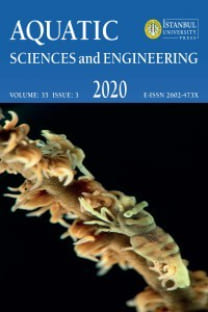Seasonal Variation of Zebra Mussel (Dreissena polymorpha Pallas, 1771) Colonization on Turkish Narrow-Clawed Crayfish (Astacus leptodactylus Eschscholtz, 1823) in Lake Eğirdir, Turkey
In this study, the hosting status of Astacus leptodactylus, which has one of the highest economic value of the inland waters fisheries of Turkey, dependent on zebra mussels (Dreissena polymorpha) was studied. Seasonal and sexual differences of zebra mussel prevalence, density situation on crayfish and some morphometric properties of zebra mussels retrieved from host were determined. Field works were carried out in January, April, July and October of 2015 with 8 fishing operations. 200 fyke net with different mesh sizes were used in sampling process. Sex of the crayfish and if they have mussels on them were determined by organoleptic observation. Mann-Whitney U, Kruskal Wallis and Chi-Square tests were used for evaluating of nonparametric data. A total of 4024 crayfish were caught and D. polymorpha was determined on 624 of them. The annual prevalence was found as 15.51% for both sex groups and it is higher in female (19.81%) than in males (9.82%). The highest mean abundance was found to be 1.93 in the spring season. The mean weights of the mussels were 0.2277 g and the average shell size was 12.3802 mm indicating a strong exponential relationship between weight and shell size.
Keywords:
Invasive alien species, freshwater ecosystems, aquatic invasions,
___
- Anonymous, A. (1985). Investigations on the Production and Population of Crayfish and Egirdir Lake. Water Product. General Directorate, Isparta Water Products Regional Director., issue. 2,21.
- Ardura, A., Zaiko, A., Borrell, YJ., Samuiloviene, A., Garcia-Vazquez, E. (2017). Novel tools for early detection of a global aquatic invasive, the zebra mussel Dreissenia polymorpha. Aquatic Conservation: Marine and Freshwater Ecosystems. 27(1):165-176.
- Atay, D. (1984). Crustacean Aquaculture Technic. Ankara Üniversitesi, Ziraat Fakültesi Yayınları, 194, 192 [in Turkish].
- Berber, S., Ates, A. S., & Acar, S. (2018). First observation of the zebra mussel (Dreissena polymorpha (Pallas, 1771)) on the narrow-clawed crayfish inhabiting in some water sources of Turkey. Su Ürunleri Dergisi, 35(1), 55-61.
- Bobat, A., Hengirmen, MO., Zapletal, W. (2001). Technical, economic and ecological harmful in freshwater ecosystem: Rural Environment Yearbook Zebra Mussels.112-129.
- Bolat, Y. (2001). Estimation population size of freshwater crayfish (Astacus leptodactylus Esch., 1823) in Hoyran region of Egirdir Lake. Süleyman Demirel University, (Phd.) Thesis 133p.
- Bush, A.O., Lafferty, K.D., Lotz, J.M., Shostak, A.W. (1997). Parasitology meets ecology on its own terms: Margolis et al. revisited. The Journal of parasitology, 83(4): 575-583.
- Brazner, J.C. and Jensen, D.A. (2000). Zebra Mussel [Dreissena polymorpha (Pallas)] Colonization of Rusty Crayfish [Orconectes rusticus (Girard)] in Green Bay, Lake Michigan. The American Midland Naturalist, 143(1):250-256.
- Erdem, M. (1993). A study on the detection of artificially observed rates of life of eggs from Egirdir Lake Crayfish (Astacus leptodactylus salinus, Nordman 1842). Suleyman Demirel University, MSc Thesis, 4-17.
- Frances, L. (2006). Early life stages of Dreissena polymorpha (Zebra mussel): the importance of long-term datasets in invasion ecology. Aquatic Invasions, 1(3): 171-182.
- Higgins, SN and Vander Zanden, MJ. (2010). What a difference a species makes: a meta-analysis of dreissenid mussel impacts on freshwater ecosystem. Ecological monographs 80(2), pp179-196, by the Ecological Society of America.
- Johnson, LE and Carlton, JT. (1996). Post-establishment spread in large-scale invasions: dispersal mechanisms of the zebra mussel Dreissena polymorpha, Ecology, 1686–1690.
- Kutluyer, F., Aksu, Ö., Aksu, Ö., 2013. Kerevitlerin beslenmesinde (Astacus leptodactylus Eschscholtz, 1823) alternatif besin olarak Zebra midyesinin (Dreissena polymorpha Pallas, 1771). Bilim ve Gençlik Dergisi, 1:2, 64-70[in Turkish].
- Martin, G. W., & Corkum, L. D. (1994). Predation of zebra mussels by crayfish. Canadian Journal of Zoology, 72(11), 1867-1871.
- Magoulick, D.D and C.Lewis, L. (2002). Predation on exotic zebra mussels by native fishes: effects on predator and prey. Freshwater Biology,1908-1918.
- Molloy, DP., Karatayev, AY., Buraklova, LE., Kurandina, DP., Laurelle, F. (1997). Natural enemies of zebra mussels, predators, parasites and ecological competitors. Reviews in Fisheries Science, 5:27-97.
- Noonburg, E. G., Shuter, B. J., and Abrams, P. A. (2003). Indirect effects of zebra mussels (Dreissena polymorpha) on the planktonic food web. Canadian Journal of Fisheries and Aquatic Sciences, 60(11), 1353-1368. doi:10.1139/f03-116
- Perry, W. L., Lodge, D. M., & Lamberti, G. A. (1997). Impact of crayfish predation on exotic zebra mussels and native invertebrates in a lake-outlet stream. Canadian Journal of Fisheries and Aquatic Sciences, 54(1), 120-125.
- Polis, GA and Strong, DR. (1996). Food web complexityand community dynamics. American Naturalist, 147:813–846.
- Reynolds, JD., Donohoe, R. (2001). Crayfish predation experiments on the introduced zebra mussel, Dreissena polymorpha, in Ireland, and their potential for biocontrol. Bulletin français de la pêche et de la pisciculture, 361:669-681.
- Rhodes, CP and Holdich, DM. (1984). Length-weight relationship, muscle production and proximate composition of the freshwater crayfish Austropotamobius pallipes (Lereboullet). Aquaculture, 37:107-123.
- Ricciardi, A., Neves, RJ and Rasmussen, JB. (1998). Impending extinctions of North American freshwater mussels (Unionoida) following the zebra mussel (Dreissena polymorpha) invasion. Journal of Animal Ecology, 67(4): 613–619.
- R Development Core Team. (2017). R: A language and environment for statistical computing. R Foundation for Statistical Computing, Vienna, Austria. ISBN 3-900051-07-0 Retrived from http://www.R-project.org.
- Stanczykowska, A. (1977). Ecology of Dreissena polymorpha (Pall.) (Bivalvia) in Lakes. Polish Archives of Hydrobiology, 24: 461–530.
- Stewart, TW., Miner, JG., Lowe, RL. (1998). Quantifying mechanisms for zebra mussel effects on benthic macroinvertebrates: organic matter production and shell-generated habitat, Journal of the North American Benthological Society, 17 (1):81–94.
- Thorp, LH., Delong, MD and Casper, AF. (1998). In situ experiments on predatory regulation of a bivalve mollusk (Dreissenia polymorpha) in the Mississippi and Ohio Rivers, Freshwater Biology, 39:649-661.
- Yayın Aralığı: Yılda 4 Sayı
- Başlangıç: 1987
- Yayıncı: İstanbul Üniversitesi
